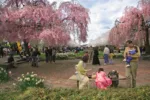[Lauren enjoys an inviting sculpture-and-textile show by Shelley Spector, whom we’ve interviewed previously on artblog radio. Inspired by a mother-daughter collaboration, Spector repurposed found objects into pieces that deserve their own new family histories. — the artblog editors]
Fiber and textile work can easily be misconstrued as crafty or kitschy, reminiscent of framed embroideries stating “Grandma Loves You,” and veering dangerously close to the territory of acrylic-yarn crocheted tea cozies adorned with googly-eyed cats. But then there are the select few who take that tiny thread and draw something beautiful with it, constructing mind-boggling structures from a single, continuous piece of what seems like nothing. Inspired by a mother-daughter embroidery in the collection of the Philadelphia Museum of Art, Shelley Spector’s moving body of work, Keep the Home Fires Burning, transforms discarded materials into inviting sculptures. What piqued the artist’s interest in the 1940s sewing collaboration by Francis Lichten and her mother, Cecilia, is the impressive size (seven by three feet) and the lively stitching of symbols and a rainbow of colors. Drawing from the textile, Spector used fabric from deconstructed clothing, and her studio was on Fabric Row–and that is where Keep the Home Fires Burning took form.
Masterful marriage of patterns and colors
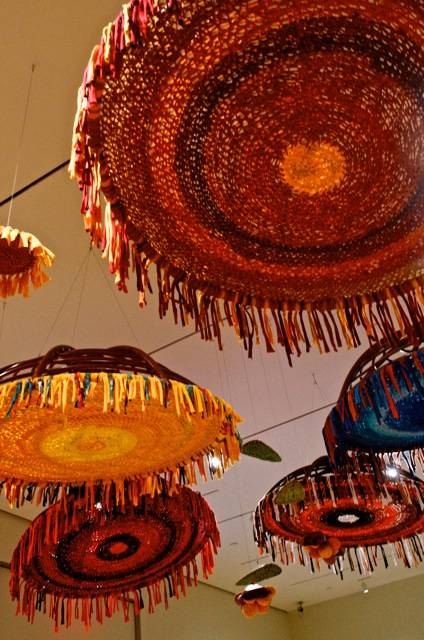
Warm music is initially what pulled me into Spector’s show. I was walking through the Perelman’s main hall and heard the pleasant plinking of strings and some warm voices joining together as they climbed sweetly into higher octaves. As I turned the corner to walk into the vast space, I was greeted by the spectacular, glowing threads of “From Seeds to Seeds”–a large, hanging series of mobiles suspended from the ceiling, creating a warm, homespun canopy above the viewer’s heads. Upon further inspection, it can be seen that each of the mobiles is built upon warped and woven stretches of wood, creating huge, upside-down wooden baskets. Each basket’s open mouth is veiled by a circular, crocheted, fringed cover–light peeking out from the open spaces between the fibers. The hanging baskets come in a group of five with some smaller counterparts dispersed throughout. They sit as planets above us: giant suns surrounded by their moons, with various meteors permeating their orbit.
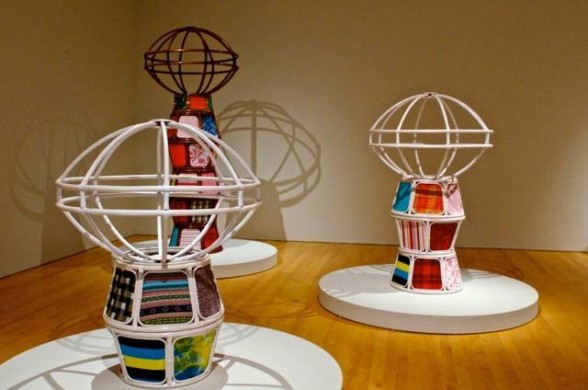
Moving on from “Seeds,” I was stopped next by three giant sculptures made from what appear to be the bottom covers of seats and the wood from wicker lawn furniture. In height order, the smallest sculpture is “In My Lifetime,” followed by “A Hundred Years,” a mid-sized twin to “Lifetime”. Last comes “A Thousand Years”—the towering, dark big sister to these two sculptures. Each features the same hollow, geometrically constructed globe of wood atop a stand of brightly colored, mismatched (but seemingly perfectly matched) chair bottoms. The patterns married together in these pieces seem to make the impossible possible: Spector has managed to make something otherwise kitschy look beautiful. Bravo, Spector.
Fantastic and more intimate pieces
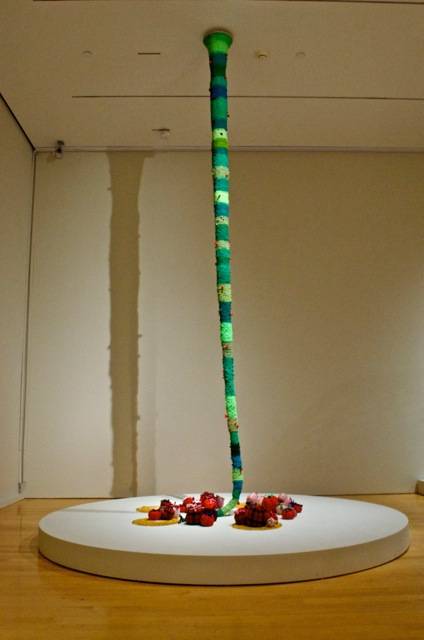
Taking up an entire corner of the room is “Village”. “Village” is an enormous woven beanstalk (of sorts) in alternating shades of green spanning from ceiling to floor in all of its Dr. Seuss-like, twisted, funneled glory. Around the base of the piece sit dozens of red fabric tomato pincushions, housing tiny needle occupants, all clustered together around the illusive, towering structure. It heralds back to childhood tales of Jack and the Beanstalk, and makes us wonder if the giant is looming above us on the second floor of the Perelman, enticing some spectator to climb Spector’s beanstalk to the next floor into some magic kingdom.
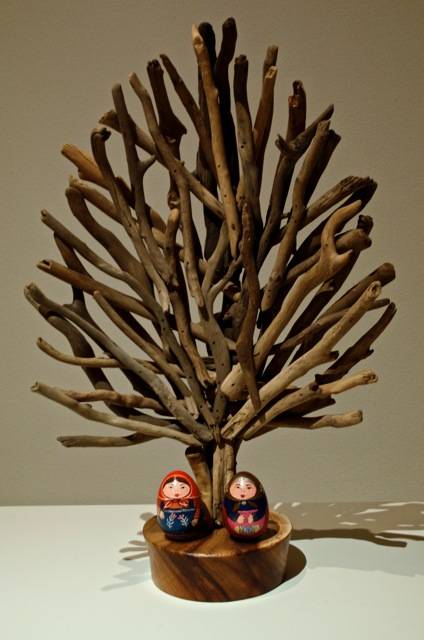
Also standing out in this body of work is a smaller sculpture titled “The Egg Tree”—an intimate piece featuring two matryoshka dolls, presumably a mother and daughter from the gray hair and brunette hair of each, standing before a driftwood tree. Spector included a few similarly intimate pieces throughout her show, but despite their small stature, they speak volumes and create a lovely tension in scale against the larger pieces. The inspirational, richly decorated embroidery is featured on the wall as one walks in; and we can see the inspiration behind each of Spector’s pieces stitched into the embroidery’s beautifully aged surface.
What is left over after leaving Spector’s show is the feeling of intimacy–like we’ve just sat down and had a heart-to-heart with the artist over a hot cup of tea, in a set of wicker chairs with mismatching seats that seem to match perfectly fine.
Keep the Home Fires Burning by Shelley Spector is on display in the Joan Spain Gallery on the first floor of the Perelman Building from March 7- Sept. 27, 2015. Gallery open from 10 am – 5 pm.


